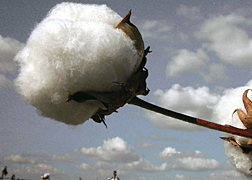|
|
USDA Scientists, International Colleagues Sequence Upland Cotton Genome
By Dennis O'Brien
April 21, 2015
Resulting "roadmap" could help improve yields, fiber quality and plant resilience
WASHINGTON, April 21, 2015—U.S. Department of Agriculture (USDA) scientists and their partners have sequenced the genome of the world's most widely cultivated and genetically complex species of cotton, a milestone that will make it easier to address increasing threats to cotton by tapping into its natural defenses. The results were published today in two Nature Biotechnology reports.
Sequencing the genome of Upland cotton (Gossypium hirsutum) will help breeders develop varieties of cotton that are better equipped to combat the pests, diseases and higher temperatures and droughts expected to accompany climate change. Cotton growers have experienced a plateau in yields since the early 1990s, and most commercial varieties lack genetic diversity, making cotton vulnerable to natural threats. The findings will help researchers and breeders in the years ahead develop cotton varieties with improved fiber qualities, higher yields and more tolerance to heat, drought and diseases anticipated due to climate change. Cotton is grown on 12 million acres in 17 states and is a $6 billion crop in the United States.
"There is a vast, untapped reservoir of genes in wild cotton plants that could offer us stronger and more effective defenses to the numerous challenges faced by cotton growers. Sequencing of a genetic standard in cotton gives us the roadmap to identify and tap into that reservoir of genetic variability," said Chavonda Jacobs-Young, administrator of the USDA's Agricultural Research Service (ARS). ARS is USDA's principal intramural scientific research agency.
The studies are the result of nearly a decade of international collaboration. ARS scientists Richard Percy and Russell Kohel (retired) are coauthors and John Yu is corresponding author of one publication. They are based in College Station, Texas. ARS scientist Brian Scheffler, based in Stoneville, Mississippi, is a coauthor of the other. The two teams sequenced the genome of the genetic standard of Upland cotton, Texas Marker-1, which is often used in studies and in developing new genetic lines.
Upland cotton is the result of millions of years of evolution and thousands of years of domestication. The sequencing efforts were made possible because several of the scientists involved in today's studies recently sequenced the two "parent" species of most commercial cotton varieties—an Old World cultivated cotton and a New World wild cotton.
The results will allow scientists to analyze two sets of extensive DNA data, compiled independently of each other, compare the results and exploit cotton's genetic diversity by tapping into the potential of genes found in the 10,000 accessions of exotic and wild cotton plants in the ARS Cotton Germplasm Collection in College Station, Texas.
The papers, with a list of the contributing authors, can be found at:
http://www.nature.com/nbt/journal/vaop/ncurrent/full/nbt.3207.html
http://www.nature.com/nbt/journal/vaop/ncurrent/full/nbt.3208.html
ARS is USDA's principal intramural scientific research agency, and this research supports the USDA priority of promoting American agriculture by conducting cutting-edge research and expanding markets at home and abroad.

